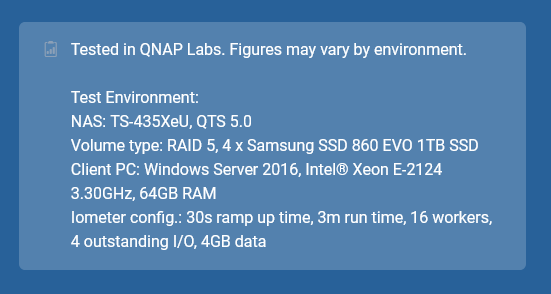Hi,
I’m trying to get high sequential data throughput on my NAS (TS-433) for video editing / fun. I do everything with windows file copy. The feature page says that 280 MB/s read or 202 MB/s write (with 4 disk SSD raid 5)
This is a kind of brain dump and feedback is welcome!
If possible can people share what performance they have? And the disk configuration?
I bought the NAS/disk before really looking into it all. I do not want to throw anything away or sell maybe add some stuff to get more performance or tweak settings or at least understand. Thats my goal.
My setup
TS-433 Qnap v5.2.3.3006 (8 jan 2025)
2x Seagate 4TB IronWolf in raid 1 (mirror).
2.5 Gbit network client and nas.
Client is high end with nvme storage.
When I got the NAS it felt the first days a bit faster writing data to it… But now it has about 2TB of data on it, It feels a bit slower (which makes sense).
Current measures
Copy files from the NAS is average 155 MB/s with spikes of 175 MB/s.
Copy files to the NAS is average of 80 MB/s no spikes (starts high for 1 sec)
I’m trying to understand why we get this speed and what is the limiting factor.
Disk performance
Disk throughput from qnap software:
Through CLI with some old basic commands:
$ hdparm -t /dev/sda -t /dev/sdb -t /dev/md1
/dev/sda:
Timing buffered disk reads: 608 MB in 3.01 seconds = 202.32 MB/sec
/dev/sdb:
Timing buffered disk reads: 592 MB in 3.01 seconds = 196.79 MB/sec
/dev/md1:
Timing buffered disk reads: 802 MB in 3.02 seconds = 265.61 MB/sec
$ echo 3 > /proc/sys/vm/drop_caches && dd if=/dev/sda of=/dev/null bs=1M count=4000
4000+0 records in
4000+0 records out
4194304000 bytes (3.9GB) copied, 20.796743 seconds, 192.3MB/s
$ echo 3 > /proc/sys/vm/drop_caches && dd if=/dev/sdb of=/dev/null bs=1M count=4000
4000+0 records in
4000+0 records out
4194304000 bytes (3.9GB) copied, 21.137790 seconds, 189.2MB/s
$ echo 3 > /proc/sys/vm/drop_caches && dd if=/dev/md1 of=/dev/null bs=1M count=4000
4000+0 records in
4000+0 records out
4194304000 bytes (3.9GB) copied, 18.758039 seconds, 213.2MB/s
The disks are 5400 RPM so I would expect lower values.
But this site UserBenchmark: Seagate IronWolf 4TB (2016) ST4000VN008
So the disks are good.
But the raid device (md1) is slower than expected. Why not 350 MB/s…
Will running “dd” I checked the disks with iostats:
extended device statistics
device mgr/s mgw/s r/s w/s kr/s kw/s size queue wait svc_t %b
sda 1 1 224.9 4.0 113348.4 7.0 495.2 5.6 23.3 4.2 97
sdb 1 1 220.9 4.0 111802.8 7.0 497.1 5.1 21.8 4.1 92
md1 0 0 445.8 3.0 224636.0 6.0 500.5 10.1 22.6 2.2 100
extended device statistics
device mgr/s mgw/s r/s w/s kr/s kw/s size queue wait svc_t %b
sda 0 0 241.4 0.5 121807.5 0.0 503.6 4.2 17.6 3.7 90
sdb 0 0 240.4 0.5 121807.5 0.0 505.6 4.5 18.6 3.8 92
md1 0 0 477.3 0.0 241061.3 0.0 505.0 8.8 18.5 2.1 100
extended device statistics
device mgr/s mgw/s r/s w/s kr/s kw/s size queue wait svc_t %b
sda 0 529 224.5 9.0 113152.0 2129.8 493.7 5.2 21.4 3.9 91
sdb 1 529 222.5 9.5 111362.0 2139.8 489.2 5.6 23.1 4.2 97
md1 0 0 449.0 0.0 225280.0 0.0 501.7 9.8 21.8 2.2 100
I see the mirror is using both disks equally.
Network Throughput
I installed iperf. See How do I install iPerf3 in QTS and QuTS hero? | QNAP
C:\iperf>iperf3.exe -c qnap
Connecting to host qnap, port 5201
[ 5] local 192.168.178.174 port 59051 connected to 192.168.178.190 port 5201
[ ID] Interval Transfer Bitrate
[ 5] 0.00-1.01 sec 282 MBytes 2.34 Gbits/sec
[ 5] 1.01-2.01 sec 282 MBytes 2.37 Gbits/sec
[ 5] 2.01-3.01 sec 284 MBytes 2.37 Gbits/sec
[ 5] 3.01-4.01 sec 282 MBytes 2.37 Gbits/sec
[ 5] 4.01-5.01 sec 282 MBytes 2.36 Gbits/sec
[ 5] 5.01-6.01 sec 282 MBytes 2.37 Gbits/sec
[ 5] 6.01-7.01 sec 279 MBytes 2.34 Gbits/sec
[ 5] 7.01-8.01 sec 283 MBytes 2.37 Gbits/sec
[ 5] 8.01-9.01 sec 283 MBytes 2.36 Gbits/sec
[ 5] 9.01-10.01 sec 279 MBytes 2.35 Gbits/sec
- - - - - - - - - - - - - - - - - - - - - - - - -
[ ID] Interval Transfer Bitrate
[ 5] 0.00-10.01 sec 2.75 GBytes 2.36 Gbits/sec sender
[ 5] 0.00-10.04 sec 2.75 GBytes 2.36 Gbits/sec receiver
iperf Done.
That looks good! The network seems okay. This is NAS sending to client.
NAS Configuration
Two disk in a RAID1. No bitmap on the mirror.
Disk setup is one logical volume type thick and no snapshots.
So where do we lose speed?
Well the network performance seems fine. The disk through put is good on the single disk but combined it doesn’t gain as I would expect / hope. Unclear to me why. Maybe when the data arrives the arm cpu is not ready? Maybe the CPU is busy feeding the NIC and reading the disk? Interrupts etcetera.
Which setting could have improvements?
- SMB multichannel
- Jumbo MTU
- SMB v3
- SMB Async
I guess Jumbo frames makes the most sense… Will test this.
Regards,
Harry

